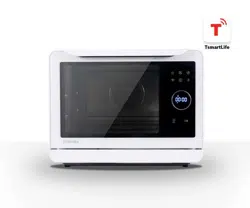Loading ...
Loading ...
Loading ...

TSmartLife APP TROUBLESHOOTING
Background :
Offering dual-band support provides choices and maximum flexibility of the product to have successful experience
on home network. Home networks can be expected to have multiple service possibilities, depending on how
their router is configured. There are four router configuration modes: A, B, C and D.
A. 2.4 GHz only … e.g. older model router
o In this case dual band radio will automatically operate at 2.4GHz
B. 5 GHz only … some people may choose to turn off older 2.4GHz band due to conflicting interference
o In this case dual band radio will automatically operate at 5GHz
C. 2.4G Hz and 5GHz sharing same SSID name … e.g. Johns
o In this case the router and dual-band radio will negotiate the best frequency to use
D. 2.4GHz and 5GHz with different SSID names … e.g. Johns _2G and Johns _5G
o In only this case is there a choice which
band to use.
If unable to join network at the first time
• Cannot see home SSID network :
o Weak signal … Since appliance radio is dual-band this means neither 2.4GHz nor 5GHz signal is being
received by the appliance. Just because the signal can be seen by the phone doesn’t necessarily mean
that the appliance radio can see it if the signal is marginal. Long distance between router and appliance or
encountering too many barriers can reduce the signal level too much. Reorienting the router may improve
the situation slightly. A better solution would be a
repeater or a higher quality router. Recognize that
all routers transmit power is limited by federal regulations, but a higher quality router can do a better
job of transmitting the signal equally in all directions, have more sensitive receivers to better handle weak
signals, and have higher quality software to minimize the dropping of connections.
• SSID network seen but cannot join:
o Networks requiring authentication …often used with public networks at restaurants or hotels.
Products cannot accept the legal agreement required to join the network. Please switch to a network
that does not require authentication.
o Insufficient encryption … for cybersecurity reasons Toshiba does not recommend products to join
non-encrypted or insufficiently encrypted networks (e.g. WEP encryption).
o Password length … for cybersecurity reasons Toshiba recommends networks to have strong passwords,
but the maximum password length supported is 32 characters.
o Incorrect password … If trying to join a different network than the one the phone is currently using,
then it is always possible that the network password in the phone is no longer correct. In this case,
new credentials will need to be provided.
o Illegal SSID name … TSmartLife App accepts any SSID name, but the App may issue warning when
attempting to join network with certain non-alphanumeric or foreign language characters.
• WLAN+ (Android) or WLAN Assistant (iOS) functions are turned on, please turn off and reconnect to the Internet.
If can join network but the connection is unstable
For configuration modes A, B and C, follow the instructions provided by your router manufacturer to make the
indicated router configuration changes :
• In case of router configuration A (see above), Toshiba recommends enabling 5GHz band if it is disabled in your
router and choosing a distinct SSID name for the 5GHz band (e.g. SSIDname_5G). Then follow the normal joining
instructions to join the 5GHz network. If your router is an older 2.4GHz only router, Toshiba recommends
upgrading to a newer dual-band router.
• In case of router configuration B (see above), Toshiba recommends enabling 2.4GHz band (all routers that offer
5GHz also support 2.4GHz), and choose a distinct SSID name for the 2.4GHz band (e.g. SSIDname_2G). Then follow
the normal joining instructions to join the 2.4GHz network.
• In case of router configuration C (see above), Toshiba recommends assigning distinct SSID names for the 2.4GHz
and 5GHz bands. Then follow the normal joining instructions to one of the networks, and subsequently follow the
troubleshooting instructions for mode D.
For these steps router configuration changes are not required:
• In case of router configuration D (see above), then it is worthwhile to try operation on the other band before
making changes to the router configuration or upgrading the router. In other words, if unstable connection using
2.4GHz then try 5GHz instead. Or if unstable connection using 5GHz then try 2.4GHz instead. Follow the
instructions below “How to set the network to 2.4GHz or 5GHz.”
• WLAN+ (Android) or WLAN Assistant (IOS) functions are turned on, please turn off and reconnect to the Internet.
If your Device offline, check your connection status Please confirm that
• Whether the device is properly powered.
• Whether the network signal is stable.
• Whether the name or password has been changed, if so, please add the device again.
Having a dual band radio in the appliance means it is not necessary to change routers or router configuration unless
problems are experienced, in which case knowing what router configuration you have (see above A, B, C or D) is
important to know and understand.
EN-04
Loading ...
Loading ...
Loading ...
